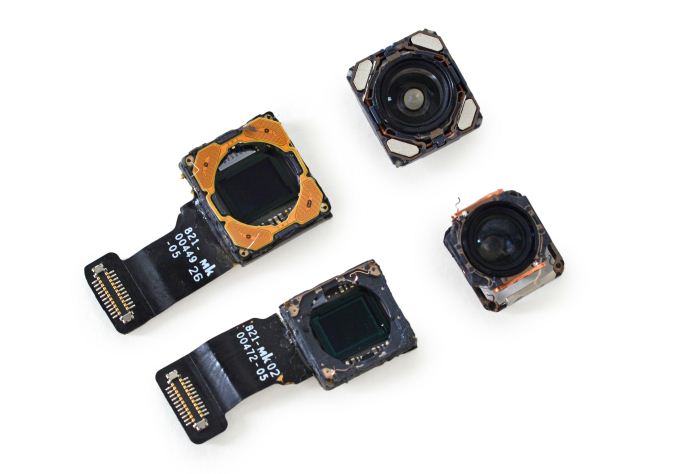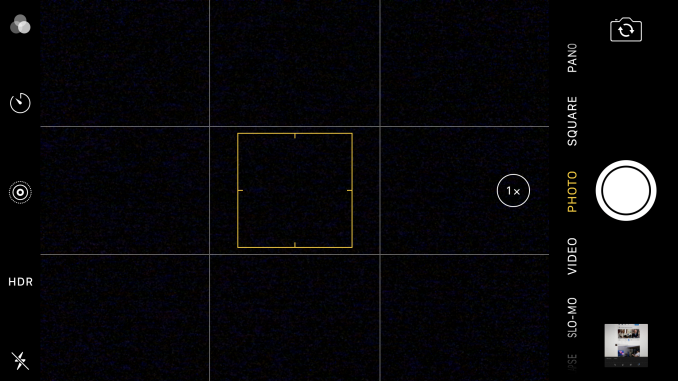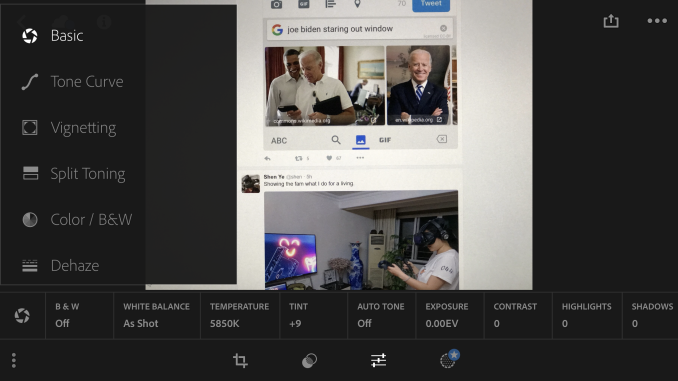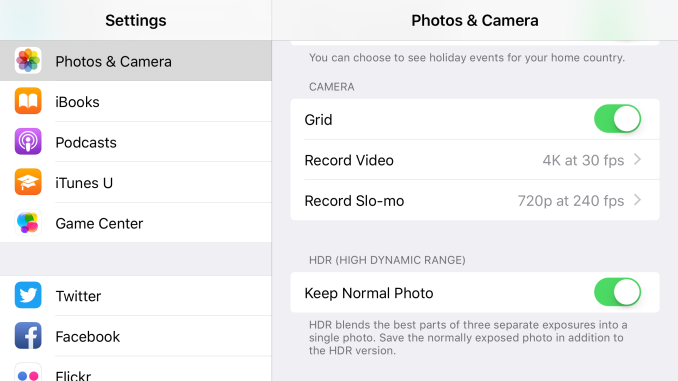The iPhone 7 and iPhone 7 Plus Review: Iterating on a Flagship
by Joshua Ho & Brandon Chester on October 10, 2016 8:00 AM EST- Posted in
- Smartphones
- Apple
- Mobile
- iOS
- iOS 10
- iPhone 7
- iPhone 7 Plus
Camera Architecture
Before we get into the results of the camera output it's always helpful to actually examine the basic characteristics and hardware that make up the camera as a number of characteristics can be predicted or understood by looking at the basic hardware. The CIS technology used can have significant impacts on noise, active area, and a number of other features including slow motion video capture. However, to say that the CIS is the only area worth examination ignores the whole chain of hardware and software needed to make a great camera. With that said we can start our look at the camera with the table below which summarizes a number of high level details for the camera.
| Apple iPhone Cameras | ||||
| Apple iPhone 6s Apple iPhone 6s Plus |
Apple iPhone 7 Apple iPhone 7 Plus |
|||
| Front Camera | 5.0MP | 7MP | ||
| Front Camera - Sensor | Sony ? (1.12 µm, 1/5") |
Sony Exmor RS (1.0 µm, 1/?") |
||
| Front Camera - Focal Length | 2.65mm (31mm eff) | 2.87mm (32mm eff) | ||
| Front Camera - Max Aperture | F/2.2 | F/2.2 | ||
| Rear Camera | 12MP | 12MP | ||
| Rear Camera - Sensor | Sony Exmor RS (1.22 µm, 1/3") |
Sony Exmor RS (1.22 µm, 1/3") |
||
| Rear Camera - Focal Length | 4.15mm (29mm eff) | 4mm (28mm eff) 8mm (56mm eff) Secondary |
||
| Rear Camera - Max Aperture | F/2.2 | F/1.8 F/2.8 Secondary |
||
Looking at the camera of the iPhone 7 in some ways the cadence has changed up a bit. While the iPhone 5s to iPhone 6 transition saw the use of almost identical camera sensor and optics, the iPhone 7 actually changes things up relative to the camera that we saw in the iPhone 6s, likely because the difference between the iPhone 6 and 6s camera was fairly mild in still photos. The iPhone 7 still appears to use a similar sensor on the rear, but with a new set of optics that incorporates a wider aperture. Apple seems to be fighting against serious z-height limitations, so we’re continuing to see a reduction in focal length as the iPhone 7 is now basically comparable to phones like the One M7 with its 28mm equivalent focal length. It’d be interesting to know transmission efficiency which would allow for proper comparisons between generations but considering how most dSLR lenses don't' list these specs it's not a surprise that we don't see this kind of disclosure.

iPhone 7 Plus's dual camera modules (Image Courtesy iFixit)
What isn’t listed on the spec sheet is that the iPhone 7 now has OIS, which is going to be a serious step up in terms of performance for anyone upgrading from the iPhone 6 or 6s. While Apple has some proprietary EIS that allows for really impressive performance despite the lack of OIS, a physical mechanism to compensate for hand shake is going to make for a more effective system in the first place, as it fixes the problem before the photons are captured. Apple continues to use advanced software to enable long exposure without visible blur or hand shake so the addition of OIS shouldn’t have any noticeable drawbacks other than increased shot latency in low light.
Of course, the iPhone 6s Plus already had OIS, so for the iPhone 7 Plus there is a new secondary camera with a focal length that is twice as long as the primary camera. However, the aperture is smaller, which means that in low light the system is going to automatically fall back to the primary camera which is still better in low light as far as I can tell, especially because the second camera lacks OIS. However, in bright daytime conditions the second camera’s longer focal length allows for better portraits and better detail in general. This helps to compensate for the iPhone’s sensor size and z-height limitations, but can only really help in daytime conditions.
Interestingly enough, Apple is actually one of the first OEMs to my knowledge to adopt a 1 micron pixel pitch for a camera sensor, but this is being done for the front-facing camera. I’m kind of curious to know what led to this decision as the optics are probably not going to be able to resolve such a small pixel size. We generally don’t review front-facing cameras but for the people that care about this sort of thing I suspect that the FFC is mostly a sidegrade in the sense that it’s probably going to be used to enable higher resolution video capture rather than higher quality still photos.
Camera UX
As far as the camera application goes, there’s really nothing new this generation. If you’ve taken pictures with a relatively new iPhone, you’re going to be right at home with the iPhone 7’s camera UI. For those that haven’t used a relatively new iPhone before we can do a quick review to discuss what is and isn’t present. At a high level, the UI is split up into a few logical sections, with mode-specific options in their own section. Modal selection is on the opposite side, with text that fairly clearly delineates the purpose of each mode. Below the modal selection, general options are presented for things like changing between front and rear cameras as well as the shutter button and camera roll.
It's hard to really say much about the iPhone camera UI at this point because it’s been polished to the point that there’s really no obvious criticisms to make about it. Apple may have made the mistake of shipping a 16:9 preview for a 4:3 camera before, but it’s been years since glaring issues like that have come up. Tapping to focus allows for either locking focus and exposure or biasing the exposure, which is going to provide coverage for 95% of still image cases. Of course, if you want more fine adjustment the default camera app is going to be inadequate, but there are plenty of good manual camera applications on the market like ProCam, ProShot, and Manual Camera.
It’s worth mentioning that while Apple was far from first to implement RAW capture on smartphones, their implementation is differentiated by a real end to end solution. Something like the HTC 10 really needs Lightroom to bring out the best in its RAW captures, although Snapseed is still reasonably useful in a pinch. Apple is leveraging their ecosystem which allows for things like fully featured Adobe Lightroom for RAW processing. I thought for a very long time that processing RAW was infeasible in the context of a smartphone TDP without fixed-function hardware, so it’s incredibly impressive to see Lightroom working smoothly when processing RAW images.
While most of the camera UX is designed well, one noticeable issue here is that the camera settings are integrated into the settings application rather than the camera application itself. If you’re used to how iOS works this makes sense, but things like resolution settings for video are placed in this menu rather than integrated into the camera application which makes switching between these settings relatively painful if you’re used to something like the HTC 10’s camera UI which places resolution settings in a slide-out drawer. This isn't a huge issue but it's definitely something I noticed due to the need to rapidly switch between resolution settings for video testing. Your mileage may vary here if you don't particularly care for such issues. Overall though, the camera UX has few friction points.













377 Comments
View All Comments
zodiacfml - Thursday, October 13, 2016 - link
Yep. The Google Pixel(s) is claimed to shoot HDR almost instantaneously which is useful to me. I don't use it if I will need flash photography on my Nexus 5. HDR is a must in most cases. White Balance is hard to fault after the HDR process.techconc - Thursday, October 13, 2016 - link
Well said. I suppose if people simply use their phones for texting, they wouldn't understand why more power is needed. I'm looking at what the iPhone 7 plus is doing with showing real time previews of fake bokeh on images in portrait mode. It's absolutely amazing what they are accomplishing on a phone these days.For that matter, try playing a game like World of Tanks Blitz on the Nexus 5X. Trust me, iPhone owners like users like them. It helps them pad their stats with more kills, etc. Honest, this "why do we need more performance" argument is pretty comical.
zodiacfml - Thursday, October 13, 2016 - link
You have a point there and I still use a Nexus 5 everyday. It is plenty fast 95% of the time and only lags during app updates which I don't mind. It is perfectly usable while doing its tasks of downloading and installing updates.I'm itching for new hardware though as the Nexus 5 could use an AMOLED display, larger battery, and external storage. A new SoC can help though with better battery life at idle or average tasks.
Yeah, I guess you are right about the 820. The 820 is impressive if found on devices around the price range of the One Plus 3. Androids with costs near an iPhone 7 is not good value.
omeryounos - Wednesday, October 12, 2016 - link
@Anadtech, really clever review. You guys totally omitted Galaxy S7 Edge (with Exynos 8890) from system performance & battery test to showcase Apple's greatest innovation ever. Especially your comments in Battery life section stating that look how much better it is from Galaxy S7 (Exynos) & omit any results from Galaxy S7 Edge (Exynos), knowingly that it will beat both iPhone 7 & Plus hands down in all battery test by hours. We (the readers) expect more balanced reviews from this site especially when it is coming weeks later than most mobile sites.BenSkywalker - Wednesday, October 12, 2016 - link
I'm curious why you didn't dive far more into Apple's utterly staggering breakthrough in LCD technology-"However, I think AMOLED's color shifting off angle puts it at a disadvantage"
Out of the hundreds of in depth instrumented tests I have witnessed and comparing hundreds of displays never have I seen a single LCD that was capable of besting *any* OLED in off angle performance- actually given the physics involved and how the displays are built, this is widely considered impossible. Given how extremely simple this is to test, I'm a bit confused as to why you haven't documented this industry changing technology and exactly what level of off angle performance improvement it shows over every other LCD ever made.
I saw the comments about off angle OLED colors being an issue in the laptop review posted a short while ago, figured you must have had a defective unit(the *only* explanation)- now you are saying this iPhone7 display bests all AMOLEDs at off angle color accuracy- really hoping you can post your measured results with exactly what degree of variation you are seeing.
Displaymate must have tested something wrong, they are still showing the iPhone7 with a catastrophic 55% drop off for brightness with some color shifting too at a mere thirty degrees, two of the photos on the front page of your review I think are also mislabeled, they say they are iPhone7 but they are showing abhorrent off angle viewing- they must be of some other, non Apple, phone.
JoshHo - Wednesday, October 12, 2016 - link
I think it goes without saying that LCD will have greater off-angle contrast reduction than AMOLED, but for color accuracy you can look at the dE2000 formula and see that changes in hue are more significant than changes in luminance in human perception of color. You can also see DisplayMate's results to see that the iPhone 7 has about a third of the color shift of the Note7's display with changes in viewing angle which is due in part to the subpixel arrangement:http://www.displaymate.com/iPhone7_ShootOut_1.htm
http://www.displaymate.com/Galaxy_Note7_ShootOut_1...
If you have any other questions or concerns please feel free to contact me by email as I don't have the time to sift through hundreds of comments searching for responses. My email is josh@anandtech.com.
philehidiot - Wednesday, October 12, 2016 - link
What I would like to see is a more in depth look at the sound quality. Not through the speakers but through headphones. The reason for this is that I attached a pair of monitoring headphones to my HTC M9 and found the top end to be incredibly harsh and distorted but when plugging those same headphones into my tablet (Kindle Fire 7 HDx) the sound was far better and there was no distortion. I would guess Apple would have better sound than the competition but a paragraph on wired headphone performance would be good and might well push more manufacturers to improve in this area. Interestingly, the Dolby "enhancements" make cheap headphones sound a load better but make decent monitoring headphones sound far worse - I assume this is because the compression applied to bring the sound into the limited dynamic range of the cheaper headphones actually helps but on the more expensive ones which can reproduce the full dynamic range of the recording it just effectively narrows it. Someone please correct me if I'm talking bollocks.UtilityMax - Wednesday, October 12, 2016 - link
For me, the iPhones do not exist, because I own a large media collection and I can't upload any of it to the iPhone without going through slow and buggy iTunes. On top of that, the iPhones do not exist for me after the 7 release after they deleted headphone jack. I own several audiophile grade but still very affordable headphone, and not of them can be used with it. I'd have to replace each one of them with a different set that costs something 2-3 times more and the benefits of doing that are pretty much dubious.So yes, in my world view, I would take a Moto G over the iPhone any day.
blackcrayon - Wednesday, October 12, 2016 - link
Sounds like you don't understand iPhones or iOS if you think you *HAVE* to use iTunes to put media on it... Hell, you don't even seem to know that they come with a headphone jack adapter for all of your "audiophile grade" headphones...UtilityMax - Wednesday, October 12, 2016 - link
I understand the iOS and issues very well. There are ways to bypass iTunes, then they still suck big time. As for the headphone jack, you can keep the headphone adapter to yourself. I am not carrying it, when it is about million times more convenient not to have to use it.